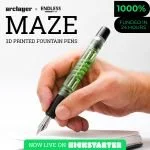(Kimberly (she/her) took the express train down the fountain pen/stationery rabbit hole and doesn't want to be rescued. She can be found on Instagram @allthehobbies because there really are many, many hobbies!.)
When I wrote this article on ink swatching over two years ago, I was using a glass dip pen, the back end of a plastic paintbrush, and a ruling pen for my swatching. Since then, I traded the glass dip pen for a Kakimori stainless steel dip nib and a few months ago, I recalled seeing an IG story where someone used a Kaweco SketchUp clutch pencil to hold their Kakimori dip nib and I knew I had to try it.
I bought a Kaweco SketchUp 5.6mm clutch pencil in Chrome on eBay, though you can find them from a variety of vendors including JetPens. Kaweco also makes the clutch pencil in 3.2 mm, so be sure to get it in the 5.6mm size as that is the one that can fit the nib.
The Kaweco SketchUp 5.6mm clutch pencil in Chrome.
Replaced the lead with the Kakimori steel dip nib.
For the past 4 months, I have been using it as my go-to for writing samples on swatch cards as well as making the lined swatches in my Endless Recorder. I had forgotten my trusty paintbrush when traveling for the holidays, so I used it to do the Col-O-Ring swatches too. Here are some things discovered:
- It is SO easy to clean the Kaweco + Kakimori! I don’t swish my Kakimori (because I don’t want it in dirty water), but I could swish if I wanted to and wipe it clean afterwards. Instead, I use a syringe at my desk to clean the nib into a dirty cup. I don’t have to worry about getting it onto the clutch mechanism since it is chrome-plated brass, and I can easily release the nib further if ink got past the clutch.
- The pencil’s clutch mechanism along with the long parallel sides of the nib makes it easy to adjust the Kakimori nib to be further in or out. Just don’t push it too far in because it could get stuck (you’d have to push the nib from the other end but it could potentially scratch/damage the sides of the nib).
- The clutch pencil is very sturdy and hefty without being overly heavy. It has a nice weight to it 1.56 oz/44.16 g) and I know it could withstand being dropped on the floor, though my hardwood floors might not appreciate that. Since I’m only using it for a few moments at a time, the weight isn’t something I really notice. That said, if you don’t want a nib holder that’s on the heavier side, you might prefer something lighter like this Tachikawa T-40 nib holder which also has the added of bonus of a cap to protect the nib. I have a similar Tachikawa holder without the cap for the brass Kakimori and that one weighs 0.39 oz/11.04 g with the nib. Kaweco also has the SketchUp 5.6 mm in other materials, like acrylic, which is lighter than the metal ones; they just aren’t as easy to find.
Kaweco SketchUp in Chrome and Brown Acrylic (note that the button is depressed further on the Chrome because the clutch is opened further to fit the nib.)
- Relatively inexpensive - Considering the heft and clutch mechanism, the clutch pencil is pretty affordable and retails for ~$40-45 depending on finish. The aluminum nib holder from Kakimori, on the other hand, goes for $72. Of course, you can also buy nib holders that are much less expensive, like the Tachikawa above, but they also won’t feel the same as the clutch pencil.
- I prefer the compact size of the Kaweco clutch pencil since other nib holders tend to be much longer. It fits easily in my pen accessories pouch which I take to meetups.
Here’s the clutch pencil next to a Kaweco AL Sport (The Little Witch) for comparison.
- You can “scratch” the paper when making swatches if you are using the tip (as opposed to the sides), especially if you go back and forth too quickly. Normally, I would say this isn’t because of the nib holder, but I think it happened more with the clutch pencil because the weight of it naturally put more pressure on the nib. I noticed this more if I didn’t change my writing angle while swatching. I have to remember to use the sides of the nib more when doing so, but it’s great for making clean lines for smaller swatches. Also, I can end up with a lot more ink than I want, so I’ve gone back to using the back end of a paintbrush for larger areas so the ink isn’t as concentrated.
Compare the relatively straight lines from the Kakimori (left) vs back of a paintbrush (yes, I am VERY backlogged with swatching.)
It is a little exaggerated here but you can see the scratchy lines that were pretty easy to make when using the tip of the nib to swatch the ink.
Swatching lines of ink (like Robert Oster’s Romeo & Juliet) is easy with the Kakimori.
I don’t remember exactly whose bright idea it was to share this combination on IG, but I thank them for it because both the pencil and nib have held up quite nicely. Now to keep working on my swatching backlog!
(Disclaimer: All items in this article were purchased by me.)
Enjoy reading The Pen Addict? Then consider becoming a member to receive additional weekly content, giveaways, and discounts in The Pen Addict shop. Plus, you support me and the site directly, for which I am very grateful.
Membership starts at just $5/month, with a discounted annual option available. To find out more about membership click here and join us!













